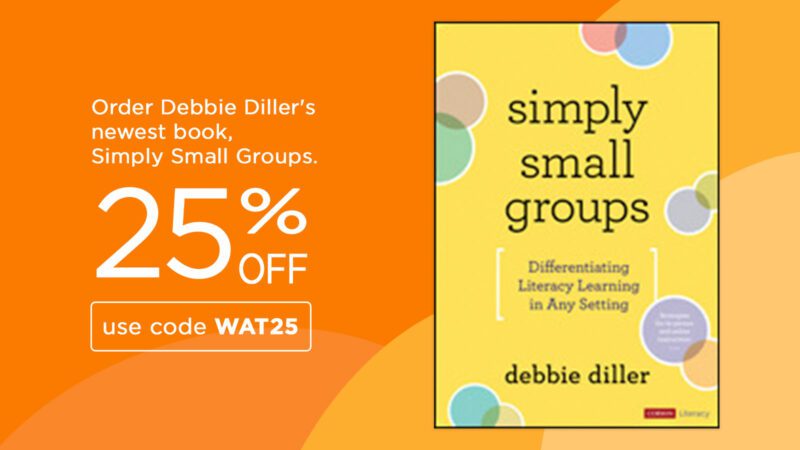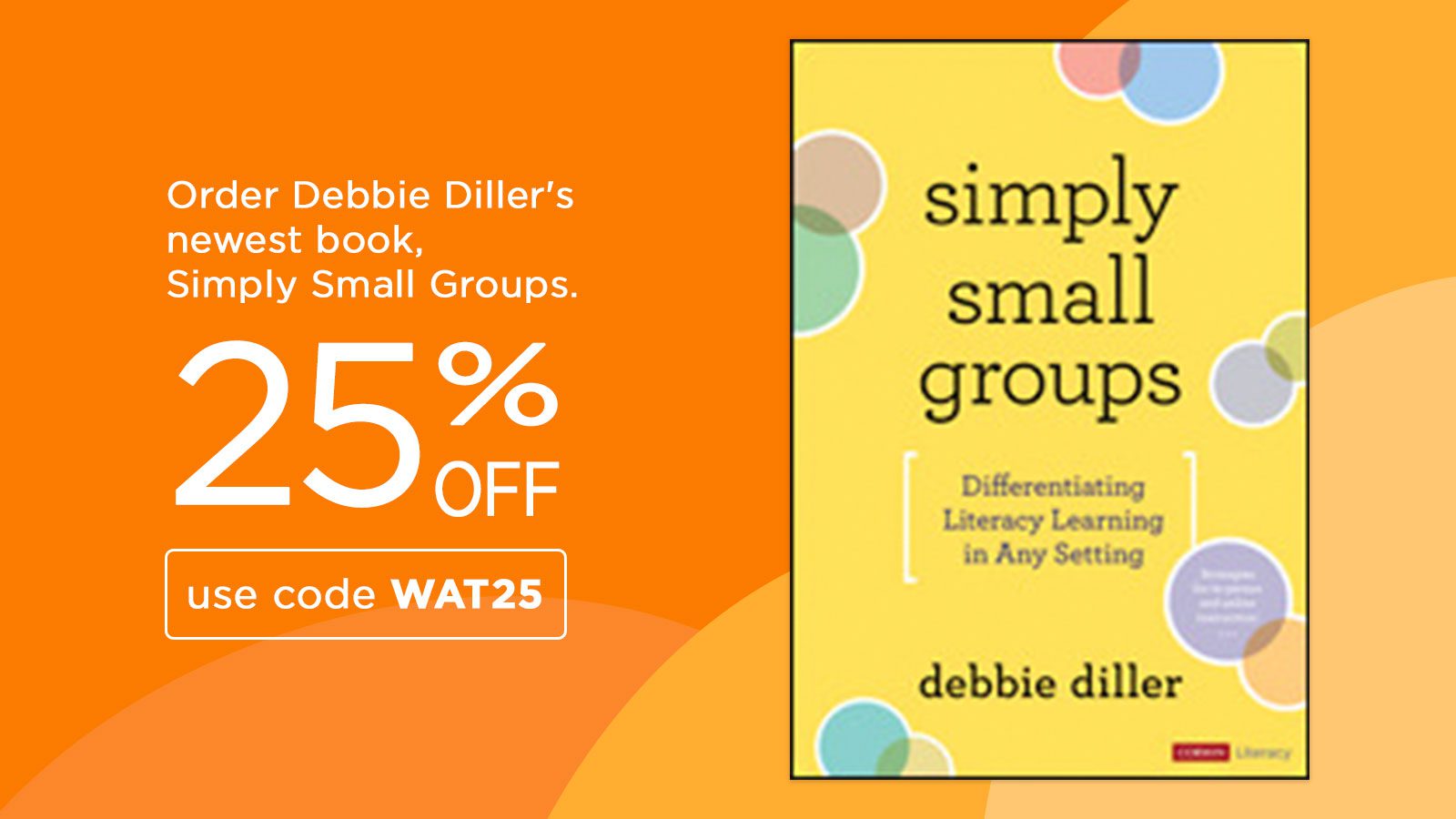Want to learn the benefits of small groups for literacy learning? Not sure how whole group instruction relates to small group instruction? Want a sample schedule for your small group time? This excerpt from Debbie Diller’s newest book, Simply Small Groups, answers all these questions and more!
The newest book in Diller’s Simply Stations series, Simply Small Groups guides you step by step through small groups for emergent, early, transitional, and fluent readers. It answers all of your questions about teaching with small groups, including organization, lesson structure, and supplies. Plus, right now, you can save 25% when you order Simply Small Groups using the code WAT25.
Below, find an exclusive preview of Simply Small Groups.
Why Are Small Groups Important for Literacy Learning?
I believe we make time for what we value the most. If we can articulate the importance of small group reading instruction, we will be more likely to include this differentiated time for students daily. The following list was generated by a group of teachers. They affirm that small group instruction:
- Accelerates children’s reading and writing growth, starting where they are
- Builds relationships between students and the teacher
- Encourages kids to feel safe to take risks and try new things as readers, writers, and thinkers
- Helps students feel like they belong at school (or online) l Allows kids to practice social skills with just a few others at a time
- Gives teachers the opportunity to more carefully observe student learning
- Provides opportunity for children to get immediate feedback l Increases participation because there are fewer kids in a small group
- Uses data to target specific student needs l Engages kids in individualized and differentiated instruction
- Gives opportunities to practice talking to students learning a new language

What Is the Purpose of Small Group Literacy Instruction?
Small group is a time to work closely with students, a time to get to know them and build on their strengths and interests. It is a time to listen, learn, and develop relationships. By working with just a few kids at a time, you can establish a safe, trusting classroom environment—and this holds true whether you’re teaching in person, online, or in any combination of the two.
The purpose of small group instruction is to work with students where they are along the continuum and help them grow. Instead of having each small group work on the same thing you’ve taught in whole group (according to your district scope and sequence), use small group time to differentiate—provide instruction that matches your students and will help them accelerate.
How Do Small Groups Fit Into the Literacy Block?
Most classroom schedules include time for whole group, small group, partner work, and one-on-one time daily. Small group is an important time of the day—an essential component no matter if you teach face-to-face, online, hybrid, or in any other setting. What follows are some sample schedules to show where small group instruction fits in the day. Be flexible and create a schedule that works for you.
Sample Primary Schedule for Literacy
- 8:00–8:10 Morning Meeting (community building time)
- 8:10–8:25 Whole Group Lesson for Modeling Using Interactive Read Aloud
- 8:25–8:45 Small Group and Literacy Stations (round one)
- 8:45–9:05 Small Group and Literacy Stations (round two)
- 9:05–9:15 Reflection Time for Stations and Small Group
- 9:15–9:20 Brain Break
- 9:20–9:35 Whole Group Lesson for Modeling Using Shared Reading and Word Study
- 9:35–9:55 Whole Class Independent Reading Time (teacher confers 1:1 or may meet with a third small group)
- 9:55–10:05 Whole Group Lesson for Modeling Writing
- 10:05–10:30 Whole Class Independent Writing Time (teacher confers with students 1:1 or may meet with a small group for writing)
- 10:30–10:40 Sharing/Reflection Time for Writing
How Does Whole Group Literacy Instruction Relate to Small Group Instruction?
Whole group is a time to model and expose everyone in your class to grade-level text and standards even if students aren’t reading at grade level. During whole group instruction, read aloud engaging text to your class. Think aloud as you model how to make predictions and connections, ask and answer questions, and infer or think beyond the text. Teach grade-level phonics lessons (and related phonemic awareness) to your class using a systematic program.
Write aloud in front of your class during whole group. Show how you come up with writing ideas, compose pieces with your children watching and helping, and reread your writing, thinking aloud about other words you might use or parts you forgot to include. It’s important for children to learn that making mistakes and not getting everything perfect are part of the process. Provide time for independent reading and writing for your whole class, too. As students read and write, walk around the room and confer with individuals. Check in to see what kids are reading and writing. Listen to some read, watch some write, invite a few to read a bit to you, and ask questions and offer encouragement and gentle nudges.
Teach well in whole group and observe during independent time before moving into small groups. Your observations and data inform what each child needs to focus on. During small group time, model with and expect students to use the same academic vocabulary you instructed with. Use conversation cards—speech bubbles that guide student discussion—as prompts and scaffolds. (You’ll find these in the Simply Stations series and references in the book.)
Over time, move graphic organizers you’ve taught with in whole group to small group as well to support learning. For example, if kids are working with character traits in small group, provide the circle map you’ve modeled with previously in whole group to help readers keep track of their thinking about characters. Allow students to use the tools that best help them comprehend. One size does not fit all.
What Is the Ideal Number of Students in Each Group? How Many Groups Should I Form?
Groups of about three to five students usually work best, depending on what kids need. Sometimes you might have only two children in a group, especially if those students need something totally different from the rest of the class. Or sometimes kids need more support and develop confidence faster in a very small group.
Occasionally there may be five or six children in a group, particularly if the students need just a little bit of support from you. But if all your groups are this large, you may not be able to give students the individualized support you’d like.
Try to make your groups small enough so that nobody can hide! It’s not necessary to try to make all groups the same size. This isn’t a simple division problem. Remember, groups are based on student needs, not numbers.
How Much Time Should I Allow for Small Group Instruction?
In kindergarten most small groups last from ten to fifteen minutes, depending on what students are working on. Meet with your youngest learners for short periods of time to keep interest and engagement high. Students in first and second grade might meet for about twenty minutes each. By third and fourth grade, the groups might last for twenty to twenty-five minutes.
If students need extra help, don’t keep them longer! See their group more often or meet with them one-on-one during independent reading time. Keep small groups short and focused. Students may take more away and end on a note of success.
Instead of trying to fit everything you can think of into a lesson, focus on one thing that you want kids to be able to do well by the end of that small group meeting. Stick with the same focus for multiple meetings and watch the benefits grow.
What Does the Rest of the Class Do During Small Groups?
The rest of your class should be engaged in meaningful work while you meet with a small group. I recommend using literacy stations—small, defined spaces (portable or stationary) where students practice with a partner. Students work together on things they can do, using familiar materials and tasks to practice reading, writing, listening, speaking, and/or working with words. Children use previously taught academic vocabulary as they engage in purposeful work that has been modeled previously in whole or small group instruction.
Curious how often you should change groups, how long it should take you to prepare, and ways to minimize interruptions? Find these answers and so much more in the book! Make sure to grab Simply Small Groups by Debbie Diller and order using the code WAT25 to save 25%.
Not sure how to determine your students’ developmental reading stage? Check out this free downloadable reading stage PDF with valuable information to help select texts for your small groups.




